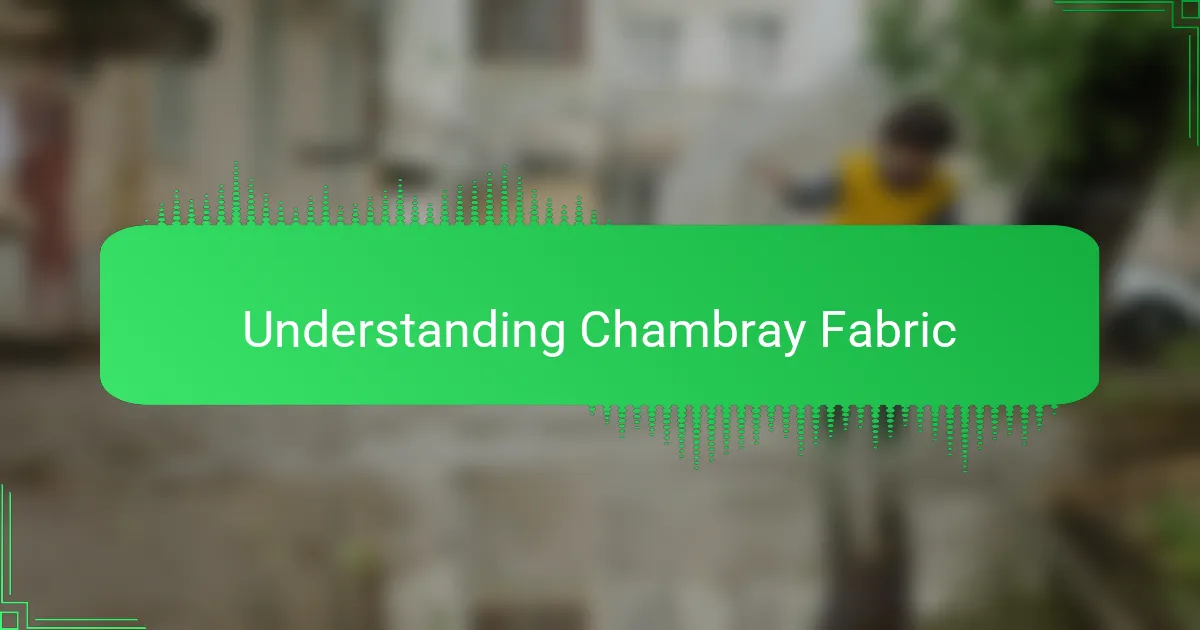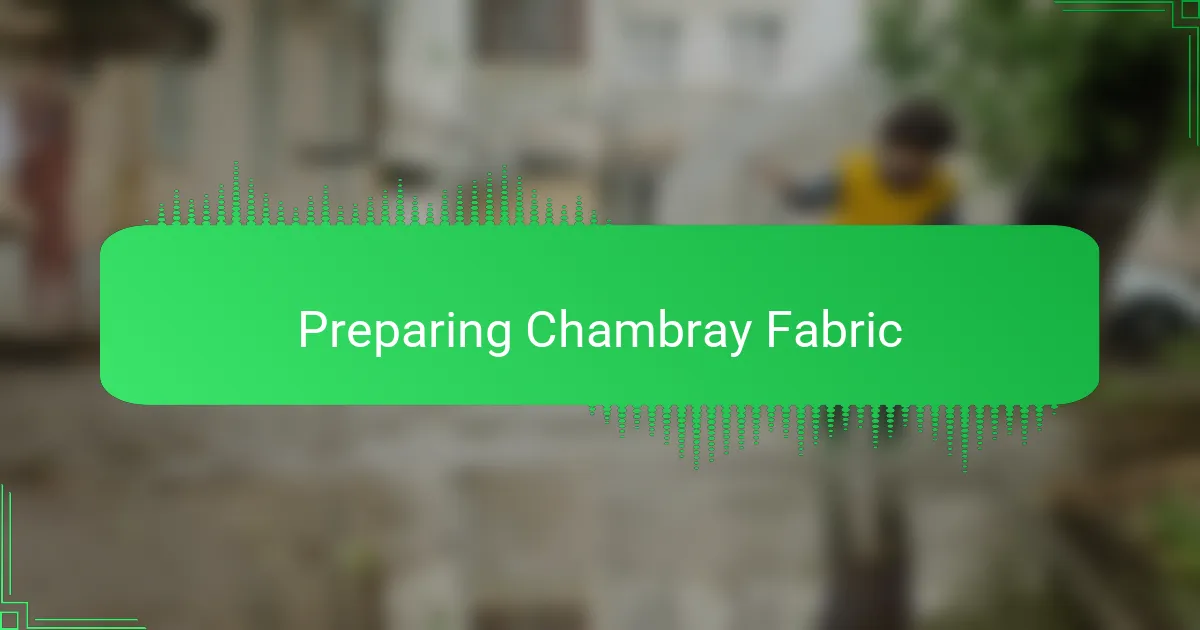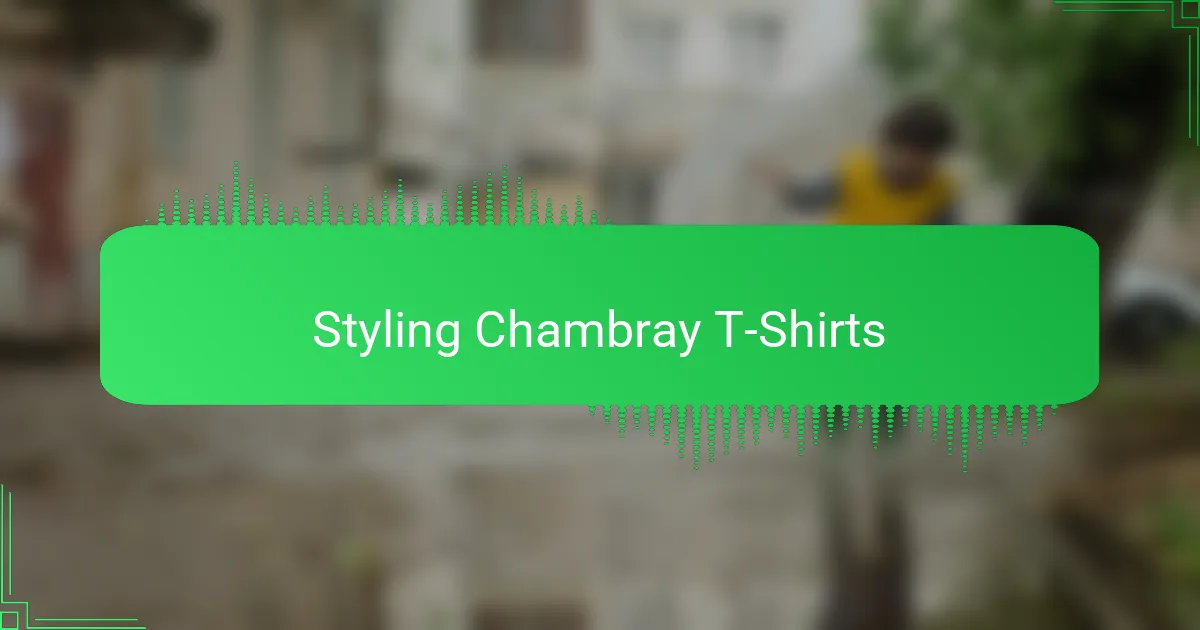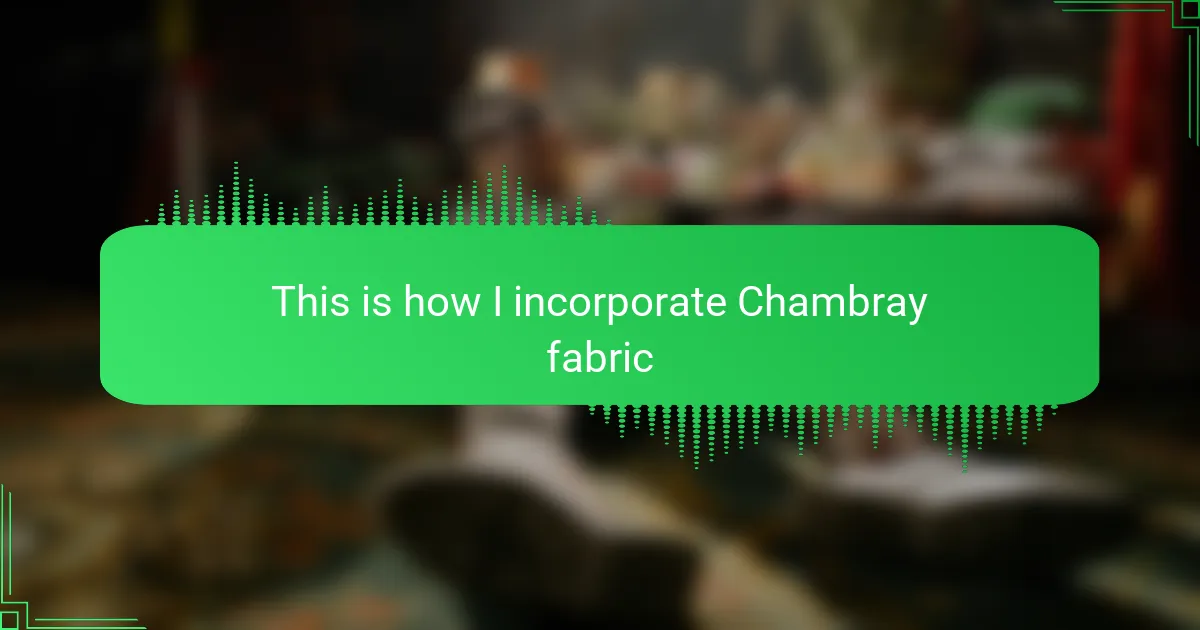Key takeaways
- Chambray is a lightweight, breathable fabric with a subtle texture, making it ideal for casual yet polished t-shirt designs.
- Preparation is key for chambray; pre-washing and ironing ensure the fabric maintains its softness and avoids shrinkage.
- Incorporating chambray in designs through contrast panels or details enhances visual interest without overwhelming the garment.
- Caring for chambray involves gentle washing, medium ironing, and proper storage to extend the life of the garments.

Understanding Chambray Fabric
Chambray fabric always feels like a refreshing surprise to me in the world of textiles. At first glance, it resembles denim with its soft blue hue, but once you touch it, the difference is clear — chambray is lighter, smoother, and much more breathable. Have you ever wondered why some fabrics just feel right against your skin? For me, chambray hits that perfect balance between comfort and style.
What I find fascinating about chambray is how it’s woven. Unlike denim, which is a twill weave creating diagonal lines, chambray uses a simple plain weave. This construction gives it that airy texture, which makes it ideal for t-shirts that need to be soft yet durable. Whenever I use chambray in my designs, I’m confident that the fabric will offer a nice drape and flexibility, which is something I crave for in casual wear.
Thinking about garments made from chambray always reminds me of warm, sunny days and relaxed vibes. This fabric has a certain nostalgic charm without feeling outdated — almost as if it invites you to slow down and enjoy comfort without sacrificing a polished look. I find myself drawn to chambray because it combines the best of both worlds: the casual feel of a t-shirt and the subtle sophistication of woven fabric. Have you tried incorporating this blend in your designs yet?

Benefits of Chambray for T-Shirts
Chambray is a fantastic fabric for t-shirts because it combines the softness of cotton with a subtle texture that adds depth to any design. From my experience, it’s perfect for casual yet polished looks—offering comfort without compromising style. I find that chambray t-shirts hold up well over time, maintaining their shape and color better than many other fabrics I’ve tried.
| Feature | Chambray |
|---|---|
| Texture | Soft with a subtle woven texture |
| Durability | High; maintains shape and color well |
| Comfort | Breathable and lightweight |
| Appearance | Casual yet polished, versatile for designs |
| Care | Easy to wash, minimal shrinking |

Choosing Chambray for T-Shirt Design
Choosing Chambray for T-Shirt Design feels like blending comfort with a touch of classic style. From my experience, chambray’s lightweight weave gives t-shirts a soft, breathable quality that’s perfect for all-day wear. I especially appreciate how its subtle texture adds depth without overwhelming simple designs.
| Feature | Chambray | Cotton Jersey |
|---|---|---|
| Texture | Subtle, slightly textured weave | Smooth, plain knit |
| Comfort | Light and breathable, good for warm weather | Soft and stretchy, versatile for all seasons |
| Appearance | Casual, with a classic denim-like look | Casual and simple, ideal for bold prints |
| Durability | Strong but can wrinkle | Durable with good elasticity |
| Design Impact | Great for subtle, textured designs | Best for vibrant and smooth-print designs |

Preparing Chambray Fabric
When I first started working with chambray fabric for t-shirt designs, I learned quickly that preparation makes all the difference. Chambray, with its lightweight and slightly textured weave, needs careful handling to preserve its soft nature. I always begin by pre-washing the fabric to prevent any unexpected shrinkage later on, which I’ve found can ruin the fit of a t-shirt if ignored.
From experience, ironing chambray before cutting ensures a smooth surface, making it easier to work with and helping the final product look polished and crisp. Here’s my go-to checklist for preparing chambray fabric:
- Pre-wash in cold water to avoid shrinkage
- Use mild detergent to maintain fabric softness
- Iron on a medium setting to remove wrinkles
- Cut on a flat surface to prevent distortion
- Check for any fabric defects or inconsistencies before cutting
Taking these steps not only saves time but also adds to the satisfaction of crafting a chambray t-shirt that feels just right.

Design Techniques with Chambray
Chambray’s lightweight and soft texture makes it a versatile choice for t-shirt design. From my experience, incorporating chambray as contrast panels or pocket details adds subtle depth without overwhelming the garment. I find that its denim-like look brings a casual yet refined touch, perfect for everyday wear.
When working with chambray, I like to experiment with stitching techniques that highlight its natural weave. For example, topstitching with a slightly heavier thread not only strengthens the seams but also creates a rustic, handcrafted vibe that I find very appealing.
- Use chambray for contrast neckbands or cuffs to add visual interest
- Incorporate chambray pockets or plackets for subtle texture variation
- Apply topstitching with contrasting thread to emphasize seams
- Layer chambray panels with cotton jersey for a soft, breathable feel
- Experiment with distressing or stone-washing to enhance chambray’s vintage character

Styling Chambray T-Shirts
Styling chambray t-shirts is where I feel the fabric truly shines. I love pairing a chambray tee with simple denim or khaki pants because the subtle texture adds a touch of sophistication without making the outfit feel overdone. Have you ever noticed how the soft sheen of chambray can elevate a basic look effortlessly?
One of my favorite styling tricks is layering chambray t-shirts under lightweight jackets or open button-ups. This adds visual interest and depth without bulk, thanks to chambray’s breathable nature. Honestly, it’s perfect for those in-between seasons when you want comfort but still look put together.
Sometimes I play with rolled sleeves or partial tucks to highlight chambray’s relaxed vibe. These little details make a big difference and keep the style casual yet polished. Do you find that small styling choices like these help bring out the best in textured fabrics like chambray? For me, it’s a simple way to make the fabric feel fresh and versatile.

Maintaining Chambray Garments
Keeping chambray garments looking their best is surprisingly simple, though I’ve learned that a gentle approach really pays off. I always wash chambray items in cold water using a mild detergent to preserve that soft texture and prevent any color fading. Have you ever noticed how rough washing can turn a once-smooth fabric stiff or dull? That’s precisely why I avoid harsh cycles or hot water.
Ironing chambray takes a little patience, but it’s worth it. I usually set my iron to medium heat and work on the reverse side to avoid any shine marks on the fabric. In my experience, this step makes a huge difference in keeping the garment crisp without sacrificing chambray’s relaxed feel. Plus, it’s oddly satisfying watching those wrinkles disappear—a bit like bringing the fabric back to life.
When storing chambray shirts or t-shirts, I prefer folding over hanging because chambray can wrinkle if left on hangers too long. I’ve found that proper care extends the life of my favorite pieces, letting me enjoy their soft, breathable charm season after season. Do you have any special tricks for caring for your textured fabrics? It’s always interesting to hear what works best for others!
